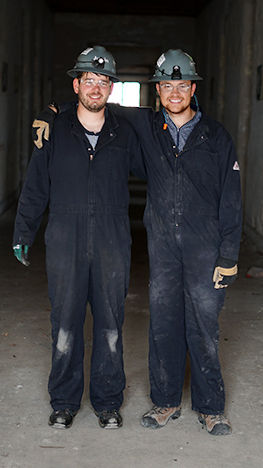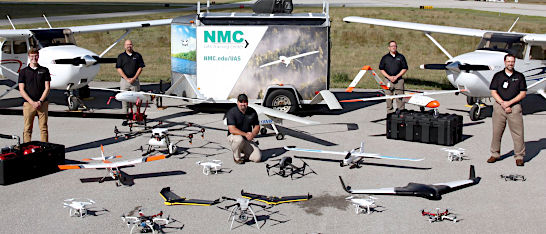September 16, 2020
This fall NMC celebrates the ten-year anniversary of its Unmanned Aerial Systems (UAS) program, a foresighted curricular addition that has helped diversify northern Michigan’s economy.
 In 2010, UAS, also known as drones, were chiefly a military tool. But Tony Sauerbrey, left, then NMC’s chief flight instructor, and others in the college’s traditional manned Aviation program spied opportunity ahead.
In 2010, UAS, also known as drones, were chiefly a military tool. But Tony Sauerbrey, left, then NMC’s chief flight instructor, and others in the college’s traditional manned Aviation program spied opportunity ahead.
“We started looking at the future of aviation, all this drone technology coming along,” said Sauerbrey, now NMC UAS program manager (far right, above.) “It was a little ahead of its time.”
Years ahead, in fact. Three classes in 2010 grew into a degree with a UAS specialty by 2013. The FAA established its commercial license in 2016. Today, drones are used to inspect crop health and infrastructure integrity, photograph and sell real estate, conduct land surveys and monitor everything from shoreline erosion to invasive species. In the future, Amazon promises drone delivery to customer doorsteps within 30 minutes.
With that significant lead in training time and experience, NMC UAS students have a decided edge in the industry with nearly 200,000 license holders nationwide. (In fact, Amazon employs several.) In northwest Michigan, the industry is growing to occupy a larger niche.
 Justin Bentsen, left and Pierce Thomas, right, during the filming of an Interactive Aerial product video. Both 2016 NMC grads, they are two of the company’s four founders.“NMC is the epicenter of all of the robotic and drone companies in the area, with an emphasis on aerial applications,” said Christian Smith, president of Interactive Aerial, a Traverse City company founded by four NMC alumni.
Justin Bentsen, left and Pierce Thomas, right, during the filming of an Interactive Aerial product video. Both 2016 NMC grads, they are two of the company’s four founders.“NMC is the epicenter of all of the robotic and drone companies in the area, with an emphasis on aerial applications,” said Christian Smith, president of Interactive Aerial, a Traverse City company founded by four NMC alumni.
Interactive Aerial is also the 2020 winner of the Emerging Business award sponsored by Traverse Connect, the region’s economic development organization. President and CEO Warren Call said the company exemplifies the organization’s desire to diversify the economy away from traditional employers like tourism/hospitality and agriculture.
“Our mission is to grow family-sustaining careers,” Call said. “The best way to do that is to develop and grow sectors that are technical, high-skill, scientific.”
A year like 2020, where both hospitality and health care, another established regional employer, suffered shows the risk of not diversifying, he said.
“We could be a leader in industries and sectors that deal with remote environments. I would love to see us be known for that,” Call said.
Fittingly, NMC launched the UAS program by partnering with one of the region’s oldest industries. Fruit growers and college supporters Dorance and Julia Amos offered their land in Yuba as a training facility back in 2010.
“For us to have access to airspace that close, that really allowed for the program to develop,” Sauerbrey said.
NMC will continue to play a pivotal role as the industry matures. Locating the program in Engineering Technology, where students learn to build and repair the units, as well as to process and analyze the many different kinds of data generated, is key. In addition, students are taught safe operating practices, airspace, weather, regulations, aerodynamics, and even aeronautical decision making.
“Industry demands more now than simple piloting skills,” Smith said, who credits Sauerbrey for guiding the program to meet industry demands. He left NMC for the private sector in 2014 but returned in 2018.
“I was very passionate about the school and what had been started,” Sauerbrey said. He sees a “second coming” of the industry ahead, as drones begin to fly beyond line of sight and over people.
“The next ten years will be very interesting,” Sauerbrey said. “Drones are not a novelty anymore and have cemented themselves as an invaluable tool in many industries and will continue to do so.”
Specialization, like Interactive Aerial’s concentration in GPS-denied environments, like tanks and boilers, will continue. Another NMC-incubated drone company, Hybrid Robotics, is about five years behind Interactive Aerial. Smith looks to NMC for the new hires he needs, and eventually for entrepreneurial colleagues.
“I hope we can be an inspiration to the next group of kids sitting in that classroom,” Smith said. “I hope that can be a snowball that doesn’t stop.”
Call agrees, adding the remote/robotic industry can help the region attract more than retirees.
“We’ve been losing that core working age demographic. Part of the reason is they have career challenges,” he said. “Developing this industry, we see as a great way to address that goal.”
Read more about the program, courses, instructors and career opportunities at nmc.edu/uas.

